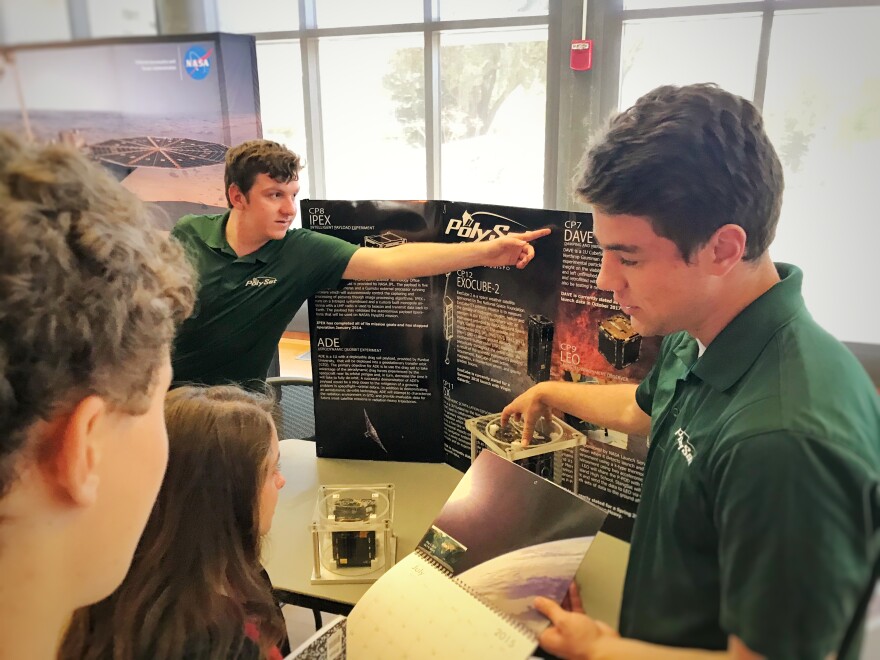If you wake up early this coming Saturday and look to the north, or the south - depending where you on are on the Central Coast - you may see history in the making.
The first Mars mission to launch from the West Coast is scheduled to take off from Vandenberg Air Force Base on May 5. Leading up to the launch, engineers and NASA staff came came to San Luis Obispo this past weekend to show the community they're headed to Mars this time around to learn a little more about our own planet.
The mission is called InSight. It stands for Interior Exploration using Seismic Investigations, Geodesy and Heat Transport. If you’re scratching your head, that’s OK. Basically, NASA is sending a machine to Mars to measure things like seismic quakes and heat. One such instrument is on display at Cal Poly.

“Its purpose is to dig into the Mars subsurface up to five meters -- that’s about 16 feet -- making measurements of thermal properties and bringing a tether behind it that'll put temperature sensors into the ground,” Troy Hudson said to the group of people huddled around him at Cal Poly’s Chumash Auditorium Saturday.
Hudson, a planetary geologist and instrument engineer at NASA’s Jet Propulsion Laboratory, was in San Luis Obispo to teach people about the InSight mission.
“The whole point of that instrument is to measure the amount of heat coming out of the interior of the planet," Hudson said. "Because heat is the engine that drives geology, and by understanding the heat on Mars today and what it might have been like in its past, we get a window into what Earth might have been like early in its past.”
Across town, some young people were also learning more about the Mars mission, by making some noise. At the San Luis Obispo Children’s Museum, Rachel Berg and Owen Boyd- Buse, in a Superman cape, were banging on the ground and watching a digital seismograph log the the vibrations.
“It kind of actually looks like a heartbeat,” Berg said. “But like a really big heartbeat. Like when you jump it makes a heartbeat.”
And why would this be important to study on Mars?

“What we’re trying to do is understand what the inside of Mars is made of, and whether mars has a liquid core and a mantle and a crust, like the Earth does, ” said Sandy Krasner, who worked on the computer systems for InSight. On Saturday, he was breaking it all down for kids at the museum.
“We’re gonna go to Mars," Krasner said. "And we’re gonna measure marsquakes. And we’re gonna measure the signals from meteorite impacts, and try to understand what the inside of Mars is made out of.”
NASA is also conducting another experiment during this mission. Part of the payload are two briefcase-sized communication satellites, known as CubeSats. These particular CubeSats are called MarCO, for Mars Cube One. If all goes according to plan, these small satellites will relay InSight data back to Earth as it enters the Martian atmosphere and lands.
This part of the mission had Cal Poly hands all over it.

“We helped with the integration into its deployer,” Cassandra Kraver said. Kraver is a third year aerospace engineer at Cal Poly, and on Saturday she was also on hand to explain the Mars mission and Cal Poly’s space accomplishments.
Kraver and other Cal Poly students helped work on the device that will kick MarCo out into space.
“In order to actually leave the launch vehicle, [MarCo] will have to get deployed," Kraver said. "So [the deployer] is like a big box that will have a door open and then a spring will push out the satellite into space where it will continue on its own.”
That's not a bad accomplishment for a third year undergrad to have on her résumé.
It’s been six years since the Curiosity rover landed on Mars in 2012. Once it arrives, InSight will be the first mission to drill into the surface of the Red Planet. And it will be carrying the first CubeSat to make an interplanetary trip.
The launch is currently scheduled from Vandenberg Air Force Base at 4:05 a.m. on Saturday, May 5. It should be visible to millions of people between San Luis Obispo and San Diego counties.





